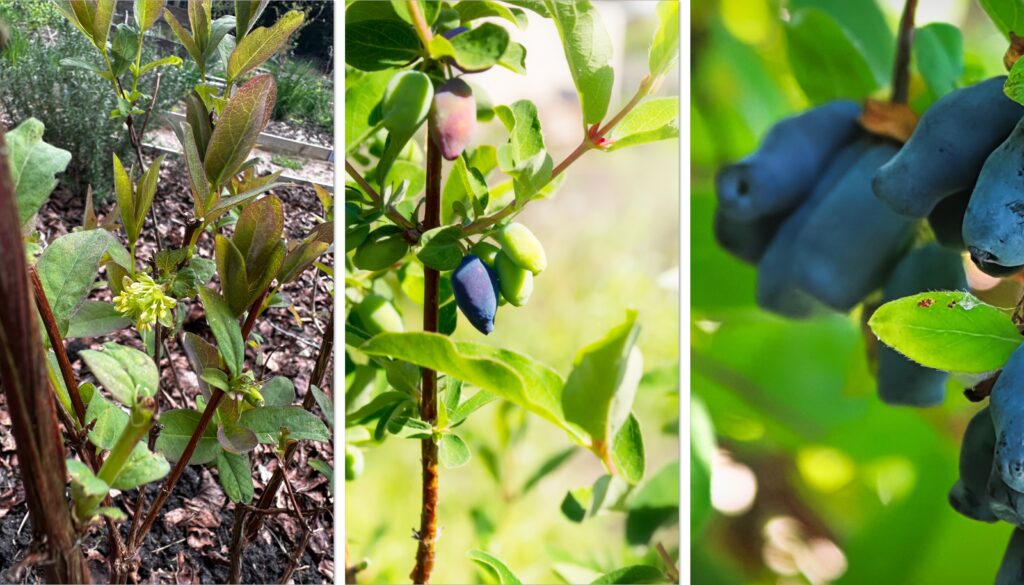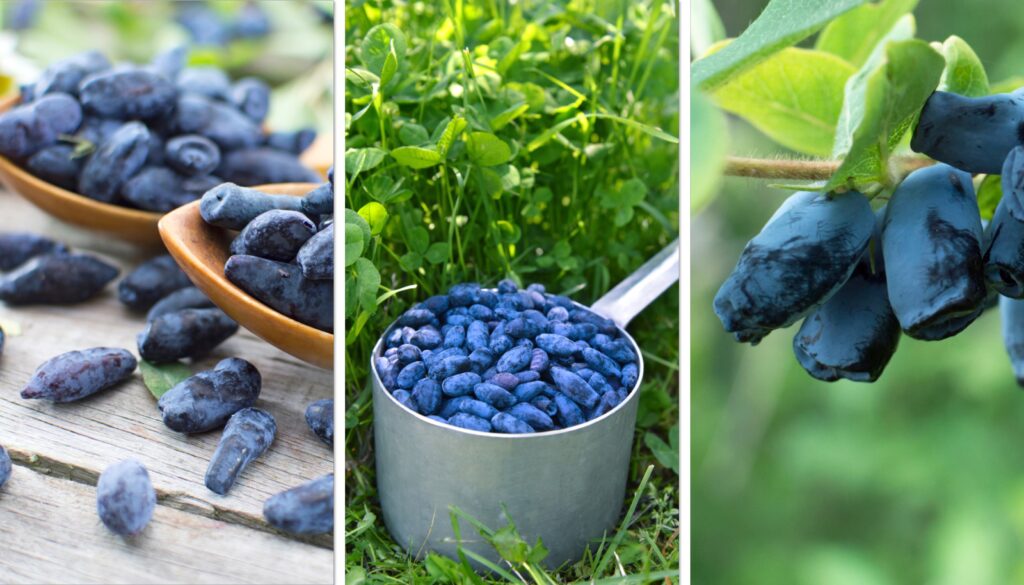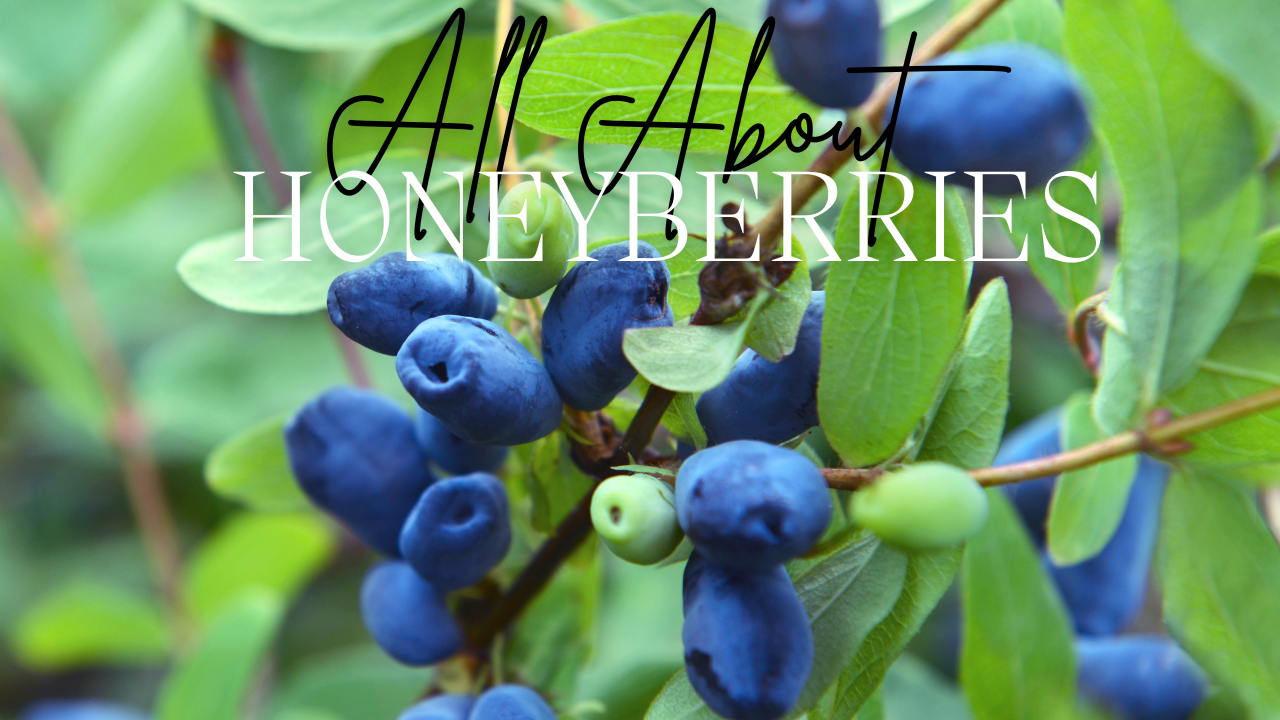Guest post by Katrina & Clayton
Honeyberries (Lonicera caerulea), also known as Haskap or edible honeysuckle, are a hardy, nutritious fruit-bearing shrub perfectly suited for the Scottish climate. These cold-tolerant plants are not only easy to grow but also yield delicious berries high in antioxidants. The deep purple, elongated berries have a tart sweet flavour reminiscent of blueberries and are rich in vitamins C and A. Enjoy honeyberries fresh, or use them in jams, jellies, smoothies, pies, and syrups.
Growing Honeyberries in Scotland
Honeyberries thrive in Scotland’s temperate climate, making them an excellent choice for gardeners.
Cold Tolerance: Honeyberries can withstand temperatures as low as -40°C, making them ideal for Scotland’s colder regions.
Early Harvest: These berries ripen in early summer, often before strawberries, offering one of the season’s first fresh fruits.
Low Maintenance: Once established, honeyberries require minimal care and are resistant to many common pests and diseases.

Planting Honeyberries
Shrub Size: Honeyberry bushes grow to a manageable size of 1-2 meters, making them suitable for small gardens.
Pollination: These plants require cross pollination, so planting at least two different varieties is essential for fruit production.
When to Plant: Plant honeyberries in early spring or autumn when the ground is not frozen and conditions are cool and moist.
Where to Plant: Select a location with full sun for optimal berry production, though honeyberries can tolerate partial shade.
How to Plant:
Prepare the Soil: Ensure the soil is well draining and rich in organic matter,
Dig the Hole: Dig a hole twice the width and depth of the root ball. Space plants 1-2 meters apart to allow for growth and airflow.
Planting: Place the bush in the hole at the same depth it was growing in the pot or nursery. Backfill with soil, firm it gently, and water thoroughly.
Mulching: Apply a layer of organic mulch to retain moisture and suppress weeds. Caledonian Green Goodness is a great peat-free soil improver that will add nutrients and organic matter to your soil.

Pruning Honeyberries
Regular pruning ensures healthy growth, good airflow, and optimal fruit production.
When to Prune: Prune honeyberries in late winter or early spring when the plant is dormant.
How to Prune: Use clean, sharp pruning shears.
Remove any dead, damaged, or diseased wood.
Thin out the center of the plant to improve air circulation.
Cut back older, unproductive branches to encourage new growth.
Avoid heavy pruning, as honeyberries fruit on older wood.
Caring for Honeyberries
Proper care ensures your honeyberry bushes thrive and produce abundant fruit.
Watering: Honeyberries need consistent moisture, especially during the first few years and fruiting season. Water deeply once or twice a week, depending on rainfall, ensuring the soil remains evenly moist but not waterlogged.
Winter Care: Mulch around the base of the plant in late autumn to protect roots from severe frost. Honeyberries are naturally hardy and typically do not require additional winter protection.
Companion Planting for Honeyberries
Companion planting enhances pollination, deters pests, and promotes healthy growth.
Good Companions
Bee-Friendly Plants: Lavender, marigolds, and borage attract pollinators that improve honeyberry fruit set.
Ground Covers: Clover and thyme suppress weeds and retain soil moisture.
Nitrogen Fixers: Peas and beans enrich the soil with nitrogen, supporting honeyberry growth.
Bad Companions
Avoid planting honeyberries near large trees or shrubs that compete for sunlight and nutrients.

Best Soil for Honeyberries
Honeyberries thrive in well drained, fertile soil with a slightly acidic to neutral pH.
Soil Preparation
Drainage: Ensure good drainage, as honeyberries do not tolerate waterlogged conditions. Add sand or gravel to heavy clay soils.
Organic Matter: Incorporate compost or well rotted manure to improve fertility and structure.
pH Testing: Conduct a soil test and amend with sulfur if the soil is too alkaline.
Long-Term Soil Care: Mulch annually to retain moisture, regulate soil temperature, and improve organic content. Rotate mulch materials (e.g., straw, wood chips) to maintain balance and prevent disease buildup.
Here are Various Ways to Enjoy Honeyberries:
Rinse honeyberries and eat them raw for a fresh, juicy snack. Their unique taste makes them a delightful addition to any fruit bowl. Combine honeyberries with strawberries, blueberries and a kiwi for a colourful and refreshing fruit salad.
Perfect for pies and tarts, use honeyberries as a filling for pies, tarts or crumbles. Their tangy flavour pairs well with sweet pastry. Add honeyberries to muffin or cake batter for bursts of fruity flavour.
Great in smoothies, blend honeyberries with yoghurt, banana, and a splash of orange juice for a nutrient rich smoothie. Make honeyberry juice or syrup to use in cocktails, mocktails, or over pancakes. They make great jams too, cook honeyberries with sugar for delicious spreads. Honeyberries also freeze well to enjoy their taste year round in recipes or as a frozen snack.
Honeyberries are a fantastic addition to gardens in Scotland, offering delicious fruit, low maintenance care, and resilience in colder climates.With their versatility in the kitchen and ornamental appeal, honeyberries are a rewarding choice for Scottish gardeners. Whether you’re new to gardening or a seasoned grower, honeyberries are sure to thrive in your garden, just remember to add two for the best harvests.
Katrina & Clayton

Katrina & Clayton live with their family in East Ayrshire in Scotland and share their daily life in the garden on instagram @buildingfoodforest_scotland. They practice permaculture principles, reducing & repurposing waste whenever they can. Katrina shows how home educating in nature has helped Clayton thrive.
Clayton Completed The Grow and Learn Course with the Royal Caledonian Horticultural Society in 2022. This year he will be completing Level 2 Nurture Course. Clayton is 16, Autistic, Non Verbal & has been Home Educated for the last 6yrs. Both Katrina and husband Peter have studied the Permaculture Design Course PDC and PDC Pro over the last 5yrs, developing their garden from grass to an ongoing food forest.
They have featured on BBC Beechgrove Gardens, Gardeners World Magazine and write for Scotland Grows Magazine. Katrina has a series of children’s story books out following the life of Clayton in the garden. Available at Amazon.
See more and follow Katrina & Clayton at the links below:
-
 Builder’s Bag Planter Mix£79.00 inc VATRated 4.93 out of 5 based on 41 customer ratings
Builder’s Bag Planter Mix£79.00 inc VATRated 4.93 out of 5 based on 41 customer ratings -
 Builder’s Bag Kelpie Compost£72.00 inc VATRated 4.96 out of 5 based on 137 customer ratings
Builder’s Bag Kelpie Compost£72.00 inc VATRated 4.96 out of 5 based on 137 customer ratings -
 Builder’s Bag Green Goodness£52.00 inc VATRated 4.90 out of 5 based on 197 customer ratings
Builder’s Bag Green Goodness£52.00 inc VATRated 4.90 out of 5 based on 197 customer ratings



